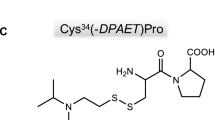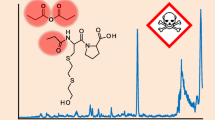Abstract
Nerve agents still represent a serious threat to civilian and military personnel as demonstrated by the violent conflict in the Middle East. For verification of poisoning, covalent adducts with endogenous proteins (e.g., human serum albumin, HSA) are valuable long-term biomarkers. Accordingly, we developed a microbore liquid chromatography-electrospray ionization mass spectrometry/high-resolution mass spectrometry (μLC-ESI MS/HR MS) method for simultaneous detection of HSA-adducts with the V-type nerve agents VX, Chinese VX (CVX), and Russian VX (RVX). Following Pronase-catalyzed proteolysis, novel disulfide-adducts were detected in addition to phosphonylated tyrosine residues. Dipeptide disulfide-adducts were formed between the thiol-containing leaving group of the V-type nerve agents (2-(diisopropylamino)ethanethiol, DPAET, for VX and 2-(diethylamino)ethanethiol, DEAET, for CVX and RVX) and the free thiol group of Cys34 in HSA (DPAET-CysPro, DEAET-CysPro). We also identified tripeptide disulfide-adducts containing Cys448 (MetProCys-DPAET, MetProCys-DEAET) and to a lesser extent Cys514 (AspIleCys-DPAET, AspIleCys-DEAET). Synthetic tripeptide references were used for confirmation of the postulated structures by μLC-ESI MS/HR MS. Lower limits of detection were determined in human plasma, being nearly identical for the three V-type nerve agents, and corresponded to 1–6 μM nerve agent for tyrosine-adducts, 1–3 μM nerve agent for CysPro-adducts, and 6 μM nerve agent for MetProCys-adducts, thus covering concentrations of toxicological relevance. Characterization of proteolysis kinetics revealed stable plateaus for all adducts being reached between 60 and 90 min at 37 °C. Adduct formation kinetics were characterized by simultaneously monitoring the V-type nerve agent, its leaving group, and the corresponding disulfide dimer. Furthermore, adduct formation patterns were investigated as a function of the molar ratio of HSA to V-type nerve agent.

Modification of human serum albumin (HSA) by V-type nerve agents Chinese VX (CVX) and RussianVX (RVX). Various tyrosine residues (Tyr???)n (e.g. most reactive Tyr411) were phosphonylated and disulfide-adducts were formed between the thiol-containing leaving group 2-(diethylamino)ethanethiol (DEAET) and at least three cysteine residues (Cys34, Cys448 and Cys514). Pronase-mediated proteolysis produced low-molecular cleavage products including phosphonylated tyrosines, dipeptide (Cys34Pro) and tripeptide (MetProCys448, AspIleCys514) disulfide-adducts that were detected by microbore liquid chromatography-electrospray ionization mass spectrometry/high-resolution mass spectrometry (μLC-ESI MS/HR MS).






Similar content being viewed by others
Abbreviations
- μLC:
-
Microbore liquid chromatography
- ACN:
-
Acetonitrile
- APCI:
-
Atmospheric pressure chemical ionization
- CAV:
-
Cell accelerator voltage
- CE:
-
Collision energy
- CP:
-
CysPro
- CVX:
-
Chinese VX
- CWA:
-
Chemical warfare agent
- DEAET:
-
2-(Diethylamino)ethanethiol
- DIC:
-
AspIleCys
- DPAET:
-
2-(Diisopropylamino)ethanethiol
- ESI:
-
Electrospray ionization
- FA:
-
Formic acid
- FV:
-
Fragmentor voltage
- HR:
-
High-resolution
- HSA:
-
Human serum albumin
- LC:
-
Liquid chromatography
- LOD:
-
Limit of detection
- MPC:
-
MetProCys
- MS/MS:
-
Tandem-mass spectrometry
- OPCW:
-
Organisation for the Prohibition of Chemical Weapons
- OPNA:
-
Organophosphorus nerve agent
- RVX:
-
Russian VX
- TFA:
-
Trifluoroacetic acid
- TiPC:
-
Tetraisopropylcystamine
- TOF:
-
Time-of-flight
- UF:
-
Ultrafiltration
References
Thiermann H, Worek F, Kehe K. Limitations and challenges in treatment of acute chemical warfare agent poisoning. Chem Biol Interact. 2013;206(3):435–43.
John H, Balszuweit F, Kehe K, Worek F, Thiermann H. Toxicokinetics of chemical warfare agents: nerve agents and vesicants. In: Gupta RC, editor. Handbook of toxicology of chemical warfare agents. 2nd ed. Burlington: Academic; 2015. p. 817–56.
Organisation for the Prohibition of Chemical Weapons. 2017. https://www.opcw.org. Accessed 13 Jul 2017.
Blanchard CM, Humud CE, Nikitin MBD. Armed conflict in Syria: overview and U.S. response. Congressional Research Service report. 2014. http://www.dtic.mil/dtic/tr/fulltext/u2/a609621.pdf. Accessed 28 Jul 2016.
Okumura T, Takasu N, Ishimatsu S, Miyanoki S, Mitsuhashi A, Kumada K, et al. Report on 640 victims of the Tokyo subway sarin attack. Ann Emerg Med. 1996;28(2):129–35.
Tsuchihashi H, Katagi M, Nishikawa M, Tatsuno M. Identification of metabolites of nerve agent VX in serum collected from a victim. J Anal Toxicol. 1998;22(5):383–8.
John H, Breyer F, Schmidt C, Mizaikoff B, Worek F, Thiermann H. Small-scale purification of butyrylcholinesterase from human plasma and implementation of a μLC-UV/ESI MS/MS method to detect its organophosphorus adducts. Drug Test Anal. 2015;7(10):947–56.
John H, Worek F, Thiermann H. LC-MS-based procedures for monitoring of toxic organophosphorus compounds and verification of pesticide and nerve agent poisoning. Anal Bioanal Chem. 2008;391(1):97–116.
Peeples ES, Schopfer LM, Duysen EG, Spaulding R, Voelker T, Thompson CM, et al. Albumin, a new biomarker of organophosphorus toxicant exposure, identified by mass spectrometry. Toxicol Sci. 2005;83(2):303–12.
Noort D, Hulst AG, de Jong LPA, Benschop HP. Alkylation of human serum albumin by sulfur mustard in vitro and in vivo: mass spectrometric analysis of a cysteine adduct as a sensitive biomarker of exposure. Chem Res Toxicol. 1999;12(8):715–21.
Gandor F, Gawlik M, Thiermann H, John H. Evidence of sulfur mustard exposure in human plasma by LC–ESI–MS-MS detection of the albumin-derived alkylated HETE-CP dipeptide and chromatographic investigation of its cis/trans isomerism. J Anal Toxicol. 2015;39(4):270–9.
John H, Siegert M, Gandor F, Gawlik M, Kranawetvogl A, Karaghiosoff K, et al. Optimized verification method for detection of an albumin-sulfur mustard adduct at Cys34 using a hybrid quadrupole time-of-flight tandem-mass spectrometer after direct plasma proteolysis. Toxicol Lett. 2016;244:103–11.
Steinritz D, Striepling E, Rudolf KD, Schröder-Kraft C, Püschel K, Hullard-Pulstinger A, et al. Medical documentation, bioanalytical evidence of an accidental human exposure to sulfur mustard and general therapy recommendations. Toxicol Lett. 2016;244:112–20.
Williams NH, Harrison JM, Read RW, Black RM. Phosphylated tyrosine in albumin as a biomarker of exposure to organophosphorus nerve agents. Arch Toxicol. 2007;81(9):627–39.
Li B, Schopfer LM, Hinrichs SH, Masson P, Lockridge O. Matrix-assisted laser desorption/ionization time-of-flight mass spectrometry assay for organophosphorus toxicants bound to human albumin at Tyr411. Anal Biochem. 2007;361(2):263–72.
Noort D, Hulst AG, van Zuylen A, van Rijssel E, van der Schans MJ. Covalent binding of organophosphorothioates to albumin: a new perspective for OP-pesticide biomonitoring? Arch Toxicol. 2009;83(11):1031–6.
John H, Breyer F, Thumfart JO, Hochstetter H, Thiermann H. Matrix-assisted laser desorption/ionization time-of-flight mass spectrometry (MALDI-TOF MS) for detection and identification of albumin phosphylation by organophosphorus pesticides and G- and V-type nerve agents. Anal Bioanal Chem. 2010;398(6):2677–91.
Sweeney PJ, Walker JM. Pronase (EC 3.4.24.4). Methods Mol Biol. 1993;16:271–6.
Kranawetvogl A, Worek F, Thiermann H, John H. Modification of human serum albumin by the nerve agent VX: microbore liquid chromatography/electrospray ionization high-resolution time-of-flight tandem-mass spectrometry method for detection of phosphonylated tyrosine and novel cysteine containing disulfide adducts. Rapid Commun Mass Spectrom. 2016;30(19):2191–200.
Kranawetvogl A, Küppers J, Gütschow M, Worek F, Thiermann H, Elsinghorst PW, et al. Identification of novel disulfide adducts between the thiol containing leaving group of the nerve agent VX and cysteine containing tripeptides derived from human serum albumin. Drug Test Anal. 2017;9(8):1192–203.
Sporty JLS, Lemire SW, Jakubowski EM, Renner JA, Evans RA, Williams RF, et al. Immunomagnetic separation and quantification of butyrylcholinesterase nerve agent adducts in human serum. Anal Chem. 2010;82(15):6593–600.
Read RW, Riches JR, Stevens JA, Stubbs SJ, Black RM. Biomarkers of organophosphorus nerve agent exposure: comparison of phosphylated butyrylcholinesterase and phosphylated albumin after oxime therapy. Arch Toxicol. 2010;84(1):25–36.
Saeidian H, Mirkhani V, Faraz SM, Naseric MT, Babri M. Characterization of isomeric VX nerve agent adducts on albumin in human plasma using liquid chromatography-tandem mass spectrometry. Eur J Mass Spectrom. 2015;21(6):783–9.
Schopfer LM, Grigoryan H, Li B, Nachon F, Masson P, Lockridge O. Mass spectral characterization of organophosphate-labeled, tyrosine-containing peptides: Characteristic mass fragments and a new binding motif for organophosphates. J Chromatogr B. 2010;878(17–18):1297–311.
Reiter G, Mikler J, Hill I, Weatherby K, Thiermann H, Worek F. Simultaneous quantification of VX and its toxic metabolite in blood and plasma samples and its application for in vivo and in vitro toxicological studies. J Chromatogr B. 2011;879(26):2704–13.
Reiter G, Müller S, Koller M, Thiermann H, Worek F. In vitro toxicokinetic studies of cyclosarin: Molecular mechanisms of elimination. Toxicol Lett. 2014;227(1):1–11.
Reiter G, Mikler J, Hill I, Weatherby K, Thiermann H, Worek F. Chromatographic resolution, characterisation and quantification of VX enantiomers in hemolysed swine blood samples. J Chromatogr B. 2008;873(1):86–94.
D’Agostino PA, Provost LR, Visentini J. Analysis of O-ethyl S-[2-(diisopropylamino)ethyl] methylphosphonothiolate (VX) by capillary column gas chromatography mass spectrometry. J Chromatogr A. 1987;402:221–32.
D’Agostino PA, Hancock JR, Provost LR. Analysis of O-ethyl S-[2-(diisopropylamino)ethyl] methylphosphonothiolate (VX) and its degradation products by packed capillary liquid chromatography-electrospray mass spectrometry. J Chromatogr A. 1999;837(1–2):93–105.
Munro NB, Talmage SS, Griffin GD, Waters LC, Watson AP, King JF, et al. The sources, fate and toxicity of chemical warfare agent degradation products. Environ Health Perspect. 1999;107(12):933–74.
Kroening KK, Easter RN, Richardson DD, Willison SA, Caruso JA. Analysis of chemical warfare degradation products. 1st ed. Wiley: Chichester; 2011. p. 33–6.
Peters T Jr. All about albumin: biochemistry, genetics, and medical applications. San Diego: Academic; 1995. p. 51–4.
Pantazides BG, Crow BS, Garton JW, Quiñones-González JA, Blake TA, Thomas JD, et al. Simplified method for quantifying sulfur mustard adducts to blood proteins by ultrahigh pressure liquid chromatography-isotope dilution tandem mass spectrometry. Chem Res Toxicol. 2015;28(2):256–61.
Schmidt C, Breyer F, Blum M-M, Thiermann H, Worek F, John H. V-type nerve agents phosphonylate ubiquitin at biologically relevant lysine residues and induce intramolecular cyclization by an isopeptide bond. Anal Bioanal Chem. 2014;406(21):5171–85.
Jokanović M, Kosanović M, Brkić D, Vukomanović P. Organophosphate induced delayed polyneuropathy in man: an overview. Clin Neurol Neurosurg. 2011;113(1):7–10.
Roche M, Rondeau P, Singh NR, Tarnus E, Bourdon E. The antioxidant properties of serum albumin. FEBS Lett. 2008;582(13):1783–7.
Colombo G, Clerici M, Giustarini D, Rossi R, Milzani A, Dalle-Donne I. Redox albuminomics: oxidized albumin in human diseases. Antioxid Redox Signal. 2012;17(11):1515–27.
Acknowledgements
JK and MG acknowledge financial support by the Deutsche Forschungsgemeinschaft under grant number FOR2372.
Author information
Authors and Affiliations
Corresponding author
Ethics declarations
Conflict of interest
The authors declare that they have no competing interests
Electronic supplementary material
ESM 1
(PDF 1.18 mb)
Rights and permissions
About this article
Cite this article
Kranawetvogl, A., Küppers, J., Siegert, M. et al. Bioanalytical verification of V-type nerve agent exposure: simultaneous detection of phosphonylated tyrosines and cysteine-containing disulfide-adducts derived from human albumin. Anal Bioanal Chem 410, 1463–1474 (2018). https://doi.org/10.1007/s00216-017-0787-7
Received:
Revised:
Accepted:
Published:
Issue Date:
DOI: https://doi.org/10.1007/s00216-017-0787-7




